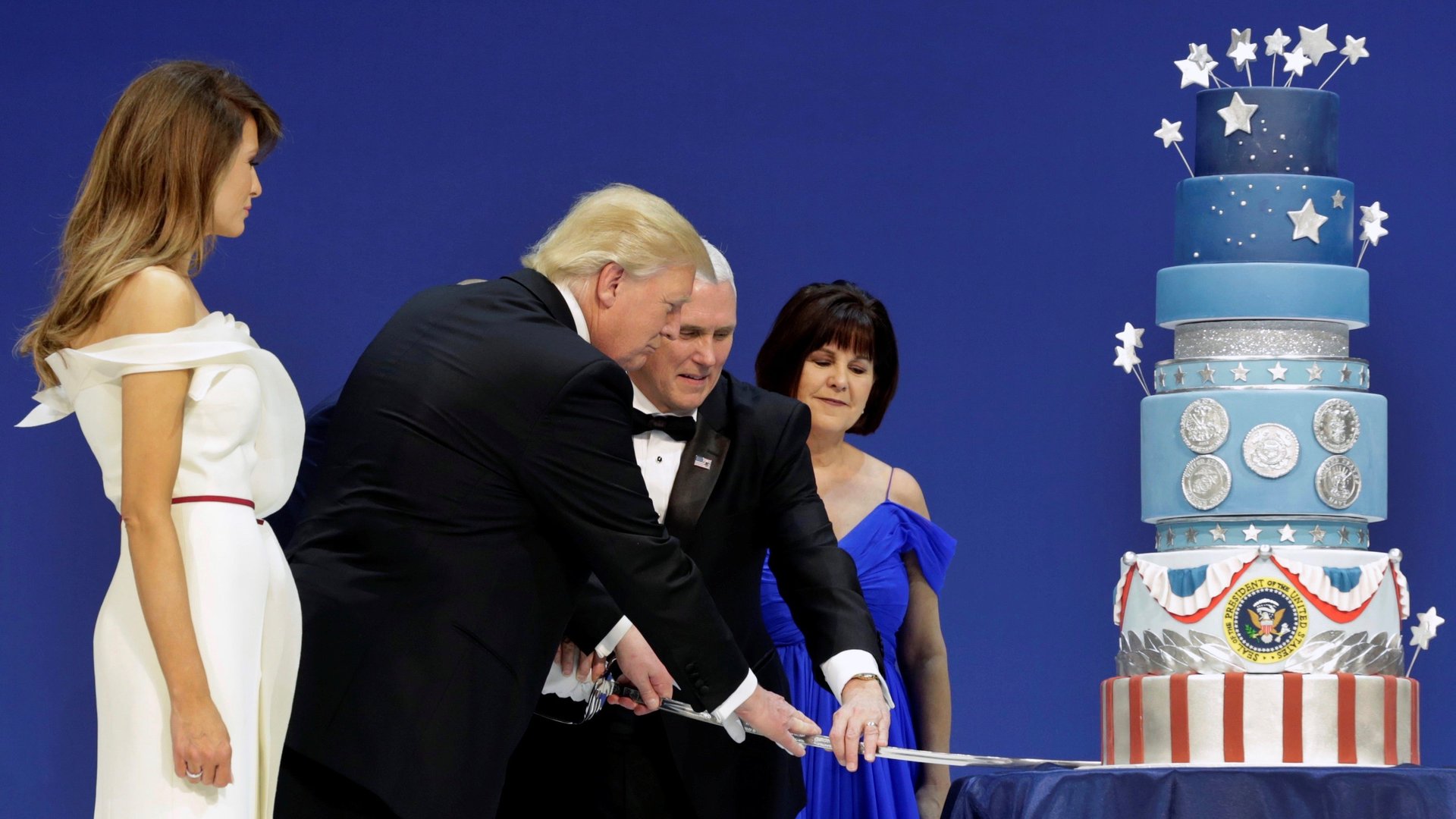Do cake designs count as intellectual property?
Cake hasn’t been controversial since the 1800s when French queen consort Marie Antoinette allegedly declared France’s poor, who had no bread, should eat brioche instead (in English: “let them eat cake”). But at US president Donald Trump’s inauguration celebrations on Jan. 20, cake became a matter of debate again.


Cake hasn’t been controversial since the 1800s when French queen consort Marie Antoinette allegedly declared France’s poor, who had no bread, should eat brioche instead (in English: “let them eat cake”). But at US president Donald Trump’s inauguration celebrations on Jan. 20, cake became a matter of debate again.
One of Trump’s celebratory cakes—created for the The Salute to Our Armed Services Ball—was an almost exact imitation of a confection made for the last Obama inauguration. The story of the copycat cake illuminates the complexity of American intellectual property law.
Duff Goldman created the original Obama cake. On Jan. 20, he tweeted images of the two confections, noting that he did not bake the cake at this year’s Trump celebrations.
The next day, Terry MacIsaac, owner of the Washington, DC, bakery Buttercream Bakeshop, took credit for the Trump cake on Instagram. She told The Washington Post that her client—an unnamed member of the Trump team—contacted the bakery with a photo a few weeks ago “pretty last minute,” seeking a copy. The baker initially tried to encourage use of the photo as “inspiration” but eventually relented and created a replica at the client’s insistence.
MacIsaac’s comments indicate that she had some sense of the slippery ground she was treading on. Bakers can’t just copy each other’s cake designs willy-nilly—though, of course, they are rarely in a position to get caught copying, since the potential evidence is meant to be consumed.
Intellectual property law is a vast and difficult topic, covering patents, copyrights, and trademarks. Generally speaking, patents protect inventions of new tangible things, copyrights protect artistic expression, and trademarks protect a name or symbol that identifies the source of goods or services.
When it comes baking, under federal intellectual property law a recipe may be patented if it qualifies as a new or novel invention, which is rare. The US Patent and Trademark Office explains that food products can be patented “when the combination of ingredients used, or the way they are processed, results in a food product totally unexpected.” These sorts of novel recipes more often come out of a lab than a kitchen.
Confections can also qualify for trademark protections if they have non-functional aspects that consumers come to recognize. For example, Carvel’s “Fudgie the Whale” ice cream cake, shaped like a whale, is a federally registered trademark.
There have been some court cases where confectionary trademark was litigated: in 2015, Disney, Sanrio (the makers of Hello Kitty), and other plaintiffs sued Michigan resident George Wilson in federal court in California for selling frosting designs they said infringed on their trademarks. The case did not get very far, however. The defendant had a pending bankruptcy case and the court stayed the IP case pending resolution of the bankruptcy case.
If there’s an issue with Trump’s Cakegate, however, it won’t be about trademark; it’ll be a fight over copyright, which protects artistic expression.
Natasha Reed, an IP lawyer at the law firm Foley Hoag in New York, explained in a 2016 blog post that when it comes to food, copyright law protects an artist’s original, creative expression fixed in a tangible medium—but not the merely utilitarian aspect. “Copyright law will apply only if the food incorporates highly creative features that are separable (either physically or conceptually) from the food’s utilitarian features,” she writes. In other words, it can’t be about the recipe.
Arguably, Goldman’s original Obama cake was an artistic expression that qualifies for IP protection. The part of the cake that was copied was his expression—his vision, the product of his mind, and not his recipe.
Still, MacIsaac was right to tell her client that they could use the Obama cake as “inspiration.” A baker who uses another’s work as inspiration is not necessarily violating copyright, Reed explains. But the line between inspiration and imitation can be fine. The critical question, MacIsaac says, ”is whether you have borrowed too much and impermissibly created a derivative work, or whether you have transformed the original into a new creation that could itself be considered original.”
A derivative work created without permission arguably infringes on copyright. But for a federal case to be made of the matter, well, someone has to make a federal case by filing a legal complaint—federal copyright laws preempted state intellectual property protections in 1978—and that isn’t likely to happen here.
There’s a fair amount of confection copyright chatter online these days as more and more people post food photos on social media, and chefs are becoming celebrities, but based on Quartz’s investigation of open cases, there doesn’t actually appear to be any active cake copyright litigation in the US. There are many possible reasons why: because the notion of cake as artistic expression qualifying for copyright is relatively new; because damages are difficult to prove; or because often a cease and desist letter is enough to stop any allegedly infringing action. For example, in 2011, the International Olympic Committee preempted any potential infringement by sending advance warning to British bakers that they could not frost cakes with the Olympics logo or any other official event symbol.
It’s unlikely the Trump Cakegate will turn litigious, either; Goldman showed solidarity with his fellow chef, MacIsaac, after things got awkward for her on Jan. 21, tweeting congratulations to Buttercream Bakery on its replica.
Goldman may have been guided to this decision by his professional ethical obligations, rather than US law. The International Association of Culinary Professionals Code of Ethics state that no culinary professional should seek to harm the reputation of another. The friendly resolution was in keeping with the baker’s obligations, and he appeared to be giving MacIsaac retroactive permission.